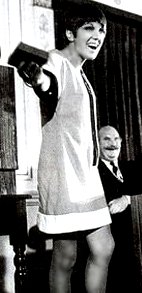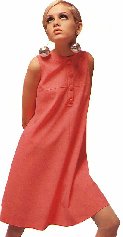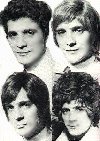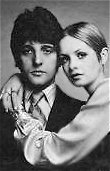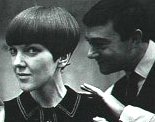|
|
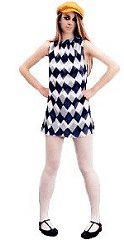
|
|
       |
By
1963 Mary had formed the 'Ginger Group' which was exporting its
own mass-produced designs to the U.S.A. and she also launched
her own cosmetics range in 1966 and footwear collection in 1967.
Shopping for clothes had become fun, a fact quickly picked up
on by many others.
Yves Saint Laurent, who had become the house designer for Christian Dior when Dior died in 1957, started his own fashion house and also opened up a chain of 160 boutiques called 'Rive Gauche', but not until 1966. Although not an innovative designer, he is important because he was the first couturier to develop ready-to-wear clothes on a large scale. In 1963 hemlines were just above the knee but the rise gained extra momentum and popularity when designs by Andre Courreges appeared in Vogue in 1964. By the end of 1965 skirts six inches above the knee were not uncommon. The changing fashion scene did not go unnoticed by the Treasury. Up until 1966 skirts under 24" long were classed as 'childrens clothing'. In fact, the dresses were becoming so small that on 5th November 1965 the government brought in new Customs and Excise rules to prevent women avoiding taxes by buying children's sizes. The 10% tax depended on the length of the clothes ..... before a rethink! From 1st January 1966 womens clothes were assessed for tax purposes according to bust size, not length. The Kings Road in Chelsea became one of the main clothes centres of Sixties London, following the success of a small lane behind Regent Street near Oxford Circus, called Carnaby Street. These were the fashion shrines of British youth in the early to mid Sixties. By 1965 Carnaby Street had become the mecca for boutiques, with all the latest clothes for the dedicated fashion followers of 'Swinging London'. The most influential retailer there, having great success in getting men to follow fashion as much as women did, was John Stephen, a grocer's son from Glasgow. He acquired his first boutique in 1963 and ended up owning ten shops in Carnaby Street with names like 'Male West One', 'Mod Male', 'His Clothes' and a similar number around other areas of the capital as well as at least two in Brighton. Other establishments included 'Lord John' owned by Warren and David Gold and 'Lady Jane' owned by Harry Fox.
Away from Carnaby Street another leading London fashion name was Barbara Hulanicki who started 'Biba' as a mail-order operation in 1964 with her ad-man husband Stephen Fitzsimon. They felt that the price of designer goods was far too high for most people and adopted and promoted the 'use for a while, throw away and buy more' marketing philosophy.
Another trendy place to shop was Cecil Gee in Shaftesbury Avenue. Fashion boutiques with bright lights, colours and pop music opened with enthusiasm all over the country. Of course, to display the clothes to their best effect, fashion models were required and the big names in fashion modelling were Jean 'The Shrimp' Shrimpton and Lesley 'Twiggy' Hornby, known as The Face and The Image of the Sixties respectively. Other top Sixties models were Patti Boyd who married Beatle George Harrison, Penelope Tree, Paulene Stone, the incredibly tall Veruschka and willowy Peggy Moffitt. In 1964 the World In Action programme produced by Granada Television made an edition called 'The Face On The Cover' in which a TV crew followed Jean Shrimpton on modelling assignments in New York and London. Terence Conran had set up his own furniture-making business in 1952, which started in a basement studio in London's Notting Hill. In 1956 The Conran Design Group was founded, initially as part of the furniture-making business. Fast becoming a leader in raising design awareness, he opened his first 'Habitat' store at 77 Fulham Road in May 1964, concentrating on modern furniture and home accessories. Conran provided innovation and good design at affordable prices, much of it imported from Europe. Habitat soon introduced Swinging London to a range of French cookware, displayed in a simple, austere environ of white-painted walls and quarry tiled flooring. Fashion-conscious Londoners flocked to his first shop, with customers such as John Lennon, Mary Quant, George Harrison and Julie Christie all buying their furniture there. The staff's uniforms were designed by Mary Quant herself.
Another style born in the previous decade was trouser suits for women, which became more popular and socially acceptable in the mid sixties. The advent of the rising hemline heralded the end for traditional stockings and suspenders which were virtually obsolete by 1965. They were replaced by the new, seamless, one-piece 'tights' in various colours and patterns. Among young males, 'quiff' hairdos were still around, but were being fast replaced by Beatle-style 'mop tops'. Drainpipe trousers survived quite happily for a while, with 'winkle picker' shoes and slim 'college' ties. Stockings returned much later, but as self-supporting items which did not need a suspender belt. New materials were also being produced. Crimplene and Trevira arrived in 1961 and happily joined the other synthetics such as Acrilan, Bri-nylon, Orlon, vinyl and PVC which provided a whole new design medium for fashion garments. Imitation leather and suede was widely used for shorter length 'car coat' styles, often with woollen collars and cuffs. A popular leather substitute was 'Corfam', made by DuPont, used by Rayne to make court shoes and also by Mary Quant for ankle boots. Synthetics also provided the basis for the shiny, sometimes collar-less 'Beatle-style', wet look two-tone suits favoured by the mods of the early Sixties. As the decade progressed, styles converged towards a unisex look, hipsters and 'T' shirts being the most common denominator. The first 'topless' dress designs appeared in 1964 at the ever more outrageous fashion shows but were unsuitable for general public wear as the proud owners soon found themselves on indecency charges. The idea, though, soon translated itself into baring other, less taboo, parts of the anatomy leading to bare midriff designs, Courreges bringing out the 'cut-out' dress with large holes cut in the sides or at the back and front, and the even more adventurous large-stitch crochet and linked-plate creations.
Shirt collars became wider, rounded and button-down. Suit lapels also became wider and 'kipper' ties abounded in ever more startling combinations of colour and design, combining the neat look of the mods with the expressive, bright colours of hippie flower-power psychedelia which reached its peak in 1967, flooding the 'alternative' fashion world with kaftans, afghan coats, beads, body paint and flowers in the hair. This year, above all others, was probably the peak in variety and diversity of cultures and fashions. It was generally a matter of the opinion of your own personal 'group' whether something was actually 'in' or not. Quite apart from being 'The Summer Of Love', 1967 was also the 'Year Of The Turtle' according to fashion paper The Daily news Record. Turtle in this case being the turtle-neck sweater which doubled both as an acceptable alternative to a collar and tie with a suit or a completely informal top with almost anything else. The garment had been around since the 20's, being a favourite of Noel Coward, but re-emerged in the Sixties both as a Beatnik favourite and, later, celebrity fashion as popularised by such as Bobby Kennedy, Paul Newman, Steve McQueen and James Coburn, among others.
Films and pop groups also affected the fashion scene. Berets became popular again after Faye Dunaway wore one in 'Bonnie and Clyde', blonde streaks after Audrey Hepburn's appearance in 'Breakfast at Tiffany's' and knee-length vinyl boots and 'space-age' designs after Jane Fonda in 'Barbarella' to name but three from the movie world. Following an appearance by The Beatles at Wembley in 1964 wearing new-look suits designed by Douglas Millings, the style was on sale in John Temple and Neville Reed shops the following October priced at 12 guineas ( £12.60 ). Hairdressers ( before the later hippie fashion for both males and females to wear their hair long and uncut ) and photographers were also closely linked to the world of fashion and were celebrities in their own right.
Twiggy's boyish 'crop' hairstyle was actually created by Len Lewis who was better known as 'Leonard of Mayfair'. He also takes the credit for creating the 'mop top' style of The Beatles who were brought to him by Brian Epstein after their sojourn in Germany in order to 'smarten up' their image. Len had been a protégé of Vidal Sassoon and, working with colourist Daniel Galvin, his own salon at 6 Upper Grosvenor Street saw many famous visitors including Judy Garland, Liz Taylor and even John F. and Jackie Kennedy when they were in town. The 'In' hairdresser for the mods in the early to mid Sixties was John Anthony's salon in Twickenham. Hair styles for men gradually lengthened as the decade progressed, through the 'mop-top Beatle' style, the raised-back Mod style and the longer, more casual 'Rolling Stones' style to the shoulder length hair favoured by the hippies of the later Sixties, often worn in permed 'Afro' style. * Memories of the Sixties Hairdressing Scene ( courtesy of Leon Simmons ) Shoe fashions changed almost weekly ranging from stiletto heel shoes to thigh length boots, and elastic-sided winklepicker 'Chelsea' boots which were a slim ankle-high boot with a wedge-blocked heel and an elastic panel on the side, handy for pulling off in a hurry. These type of boots were inspired by English horse-riding attire, but they achieved 'must have' status in the fashion world when the The Beatles and other top pop artists were seen wearing them. Cuban heels or the addition of buckles were also an option Other popular footwear included Hush Puppies, Clarks 'desert' boots or Doc Martens, depending on your particular taste and what your 'group' were wearing - bowling shoes were even the height of fashion for a short period! Also popular was the 'Courreges boot', mid calf length with open slots at the top and a tassle or bow in front. These were made of white kid, calf or patent leather. 'Doc Martens' were invented when the German Dr Maertens injured his foot in a ski-ing accident in Bavaria. He could hardly have foreseen that the orthopaedic-style shoe he designed for himself would become a fashion item, much less the archetypal symbol of rebellion it's descendents were to find themselves. The Grigg family acquired rights to the air cushioned sole in 1958 and started making boots at their Wollaston factory, producing the first boot on the 1st April 1960, hence the style name '1460'. Back in the early Sixties, carry-overs from the late Fifties Beatnik fashion (which also influenced design later in the decade) were sandals for men, flat shoes for women with berets being an early 'must have' fashion item. Even Dior designed a collection of 'beatwear' which included tight black pants and fitted leather jackets. The Edwardian-based fashions of the Teddy Boys (teenaged 'rock and roll' rebels who originated from the more deprived London areas of the early Fifties) which included long slim jackets with velvet trim, thin 'bootlace' ties, short stovepipe trousers revealing brightly patterned socks and suede 'brothel creepers' or 'winkle-pickers' were being adopted in modified styles by the early Sixties 'Mods'. By 1962 tight jeans were a key part of the early Mod scene, popular with both women and men, and more or less retained until they began being replaced by the flared, shredded and patched jeans of the Hippie movement. The trouser suit for women, introduced by designers in the early 60s, was highly controversial and was frowned upon by the upper classes, being perceived as 'poor woman's' dress. Some establishments refused entry to anyone wearing them - an attitude which changed somewhat in 1963 when the style 'took off' almost overnight after 'Ready Steady Go's Cathy McGowan wore them on the TV pop show. Prior to 1962, sleeves were either 'long' or 'short'. Then someone came up with the idea of a three quarter length sleeve which ended halfway down the forearm. There was no real fashion basis for the style, just the fact that it hadn't been done before, therefore it was an instant, massive hit. Hemlines continued to rise and, by 1968, had become what was not much more than a very wide belt - the 'micro' skirt - so it seemed the only way to go was down. The straight midi skirt, calf length, took over in 1969 soon followed by the ankle length maxi. This design change also affected the length of coats and it was not unusual to see mini or micro skirts being worn under an open, ankle length coat.
The Portobello Road was one of the favourite alternative places to go, offering uniform style items, sometimes the real thing, at a fraction of the cost of the designer equivalent and pretty well qualified for the title 'fashion centre' itself, although it supplied demand rather than created it. Psychedelia was a completely international influence and many European designers like Elio Fiorucci and Emilio Pucci were making use of the bolder colours and patterns. Outside of the hippie world, the 'Regency' or 'Romantic' look evolved from Mod in 1967-68, involving the use of frills and bows and crushed velvet. It was really after this stage, with fashions diversifying so much that the drive and vitality started to drop out of the fashion market, with minor changes and styles coming and going without great success and mingling with the various 'left over' fashions from earlier in the decade such as 'skinny-rib' sweaters and tie-dyed garments. Other fashion items worth mentioning from the middle and end of the decade are wet-look PVC coats, crocheted dresses and bikinis and the futuristic 'space age' designs of Paco Rabanne which involved the use of metallic discs or plates and day-glo colours. Also, evening and 'formal' dresses were increasingly influenced by hippie designs. Another 'name' of Sixties fashion was Zandra Rhodes who came to the forefront in the latter part of the decade when she opened her Fulham Road clothes shop. Specialising in fantasy evening wear, her use of bright colours and her outrageous designs were perfectly attuned to the psychedelic culture of 'flower power'. It
would take a very much larger article than this to even start
to investigate the fashions of the Sixties in detail as fads were
regional as well as national and international, and changed almost
weekly, as immortalised in the words of the Kinks' 'Dedicated
Follower of Fashion', but it is probably sufficient just to say
that it was all NEW and, for a while, it was great fun!

   
 Some of the many Sixties related books available from Amazon - click on the images for details |
|
|
UK
Web Hosting by
Velnet web
hosting UK | Search
Engine Optimisation & Submission by Submit
Express
Web Address Domain Names from Web Hosting Shop |
All
original material
|

